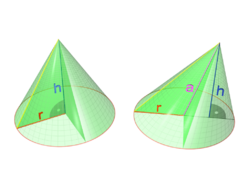Cone (geometry)
A cone is a three-dimensional geometric shape consisting of all line segments joining a single point (the apex or vertex) to every point of a two-dimensional figure (the base). The term cone sometimes refers to just the lateral surface of a solid cone, that is, the locus of all line segments that join the apex to the perimeter of the base.
The line joining the apex of the cone to the center of the base (suitably defined) is called the axis. In common usage and in elementary geometry, the base is a circle, and the axis is perpendicular to the plane of the base. Such a cone is called a right circular cone.
When a right circular conical surface is intersected by a plane, the curve produced at the intersection is called a conic section (or conic). Circles, ellipses, parabolas, and hyperbolas are all conic sections. The study of cones and conic sections is important not only for mathematics and physics but also for a variety of engineering applications.
Elements and special cases
The perimeter of the base is called the directrix, and each of the line segments between the directrix and apex is a generatrix of the lateral surface.
In general, the base of a cone may have any shape, and the apex may lie anywhere. However, it is often assumed that the base is bounded and has nonzero area, and that the apex lies outside the plane of the base.
Circular cones and elliptical cones have circular and elliptical bases, respectively. A pyramid is a special type of cone with a polygonal base.
If the axis of the cone is at right angles to the base then it is said to be a "right cone"; otherwise, it is an "oblique cone."
A cone with its apex cut off by a plane parallel to its base is called a truncated cone or frustum.
The base radius of a circular cone is the radius of its base; often this is simply called the radius of the cone.
The aperture of a right circular cone is the maximum angle between two generatrix lines; if the generatrix makes and angle θ to the axis, the aperture is 2θ.
Infinite and doubly infinite cones
In mathematical usage, the word cone is also used for an infinite cone, which is the union of any set of half-lines that start at a common apex point. This type of cone does not have a bounding base and extends to infinity. A doubly infinite cone (or double cone) is the union of any set of straight lines that pass through a common apex point, and therefore extends symmetrically on both sides of the apex. Depending on the context, the word may also mean specifically a convex cone or a projective cone. The boundary of an infinite or doubly infinite cone is a conical surface. For infinite cones, the word axis usually refers to the axis of rotational symmetry (if any).
Formulas
The volume of any conic solid is one third the area of the base times the height (the perpendicular distance from the base to the apex).
The center of mass of a conic solid is at 1/4 of the height on the axis.
Right circular cone
For a circular cone with radius r and height h, the formula for volume becomes
For a right circular cone, the surface area is
- where is the slant height.
The first term in the area formula, , is the area of the base, while the second term, , is the area of the lateral surface.
A right circular cone with height and aperture , whose axis is the coordinate axis and whose apex is the origin, is described parametrically as
where range over , , and , respectively.
In implicit form, the same solid is defined by the inequalities
- ,
where
- .
More generally, a right circular cone with vertex at the origin, axis parallel to the vector , and aperture , is given by the implicit vector equation where
- or
where , and denotes the dot product.
See also
- Circle
- Conic section
- Ellipse
- Hyperbola
- Parabola
- Pyramid (geometry)
ReferencesISBN links support NWE through referral fees
- Arnone, Wendy. 2001. Geometry for Dummies. Hoboken, NJ: For Dummies (Wiley). ISBN 0764553240
- Hartshorne, Robin. 2002. Geometry: Euclid and Beyond. Undergraduate Texts in Mathematics. New York: Springer. ISBN 0387986502
- Research and Education Association. 1999. Math Made Nice-n-Easy Books #7: Trigonometric Identities & Equations, Straight Lines, Conic Sections. Piscataway, N.J.: Research & Education Association.
- Smith, Karen E. 2000. An Invitation to Algebraic Geometry. New York: Springer. ISBN 0387989803
- Stillwell, John. 1998. Numbers and Geometry. Undergraduate Texts in Mathematics. New York: Springer. ISBN 0387982892
External links
All links retrieved March 17, 2017.
- Spinning Cone Math Is Fun.
Credits
New World Encyclopedia writers and editors rewrote and completed the Wikipedia article in accordance with New World Encyclopedia standards. This article abides by terms of the Creative Commons CC-by-sa 3.0 License (CC-by-sa), which may be used and disseminated with proper attribution. Credit is due under the terms of this license that can reference both the New World Encyclopedia contributors and the selfless volunteer contributors of the Wikimedia Foundation. To cite this article click here for a list of acceptable citing formats.The history of earlier contributions by wikipedians is accessible to researchers here:
The history of this article since it was imported to New World Encyclopedia:
Note: Some restrictions may apply to use of individual images which are separately licensed.

















![{\displaystyle [0,h]}](https://wikimedia.org/api/rest_v1/media/math/render/svg/dbede90a8f7ff59267c875f09e715c896ce7a51a)







